radiator cap OLDSMOBILE INTRIGUE 1998 Owners Manual
[x] Cancel search | Manufacturer: OLDSMOBILE, Model Year: 1998, Model line: INTRIGUE, Model: OLDSMOBILE INTRIGUE 1998Pages: 340, PDF Size: 17.93 MB
Page 209 of 340
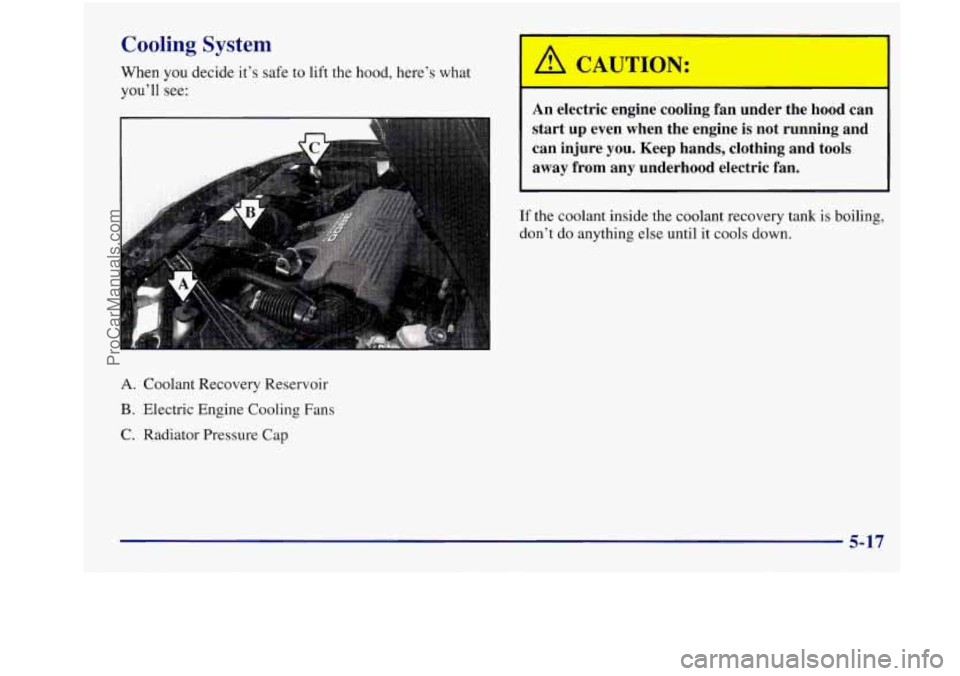
Cooling System
When you decide it’s safe to lift the hood, here’s what
you’ll see:
A. Coolant Recovery Reservoir
B. Electric Engine Cooling Fans
C. Radiator Pressure Cap
I A CAUTION:
An electric engine cooling fan under the hood can
start up even when the engine is not running and can injure you. Keep hands, clothing and tools
away from any underhood electric fan.
If the coolant inside the coolant recovery tank is boiling,
don’t do anything else until
it cools down.
5-17
ProCarManuals.com
Page 210 of 340
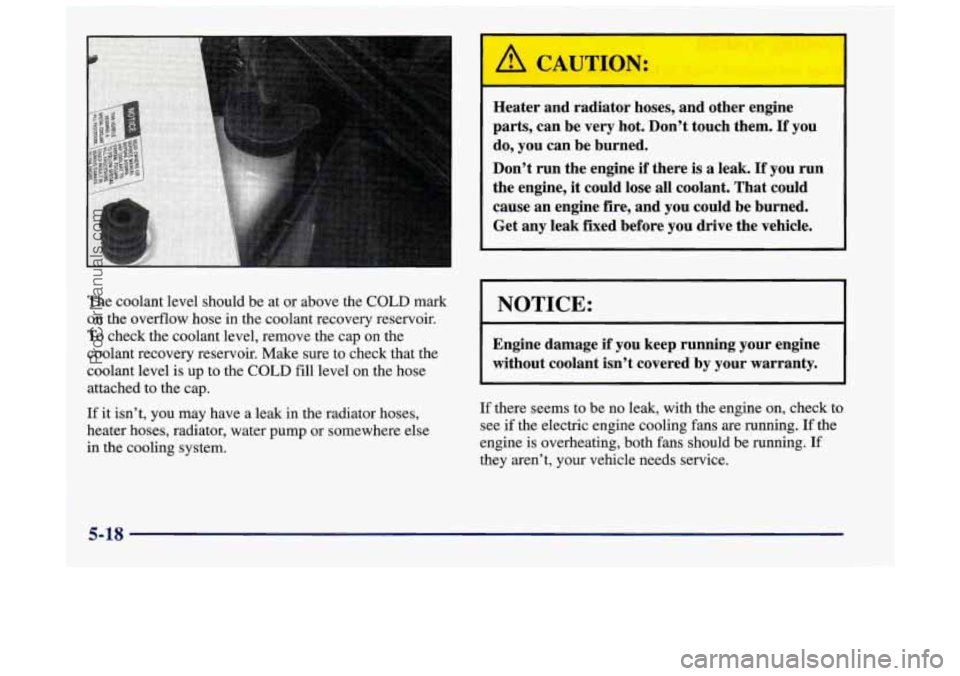
The coolant level should be at or above the GOLD mark
on the overflow hose in the coolant recovery reservoir.
To check the coolant level, remove the cap on the
coolant recovery reservoir.
Make sure to check that the
coolant level
is up to the COLD fill level on the hose
attached
to the cap.
If it isn’t, you my have a leak in the radiator hoses,
heater hoses, radiator, water pump or somewhere else
in the COO& system.
Heater and radiator hoses, and other engine
parts, can be very hot. Don’t touch them.
If you
do, you can be burned.
Don’t run the engine
if there is a leak. If you run
the engine,
it could lose all coolant. That could
cause an engine fire, and you could be burned.
Get any leak fixed before you drive the vehicle.
I NOTICE:
r
Engine damage if you keep running your engine
without coolant isn’t covered
by your warranty.
If there seems to be no leak, with the engine on, check to
see
if the electric engine cooling fans are running. If the
engine is overheating, both
fans should be running. If
they aren’t, your vehicle needs service.
5-18
ProCarManuals.com
Page 212 of 340
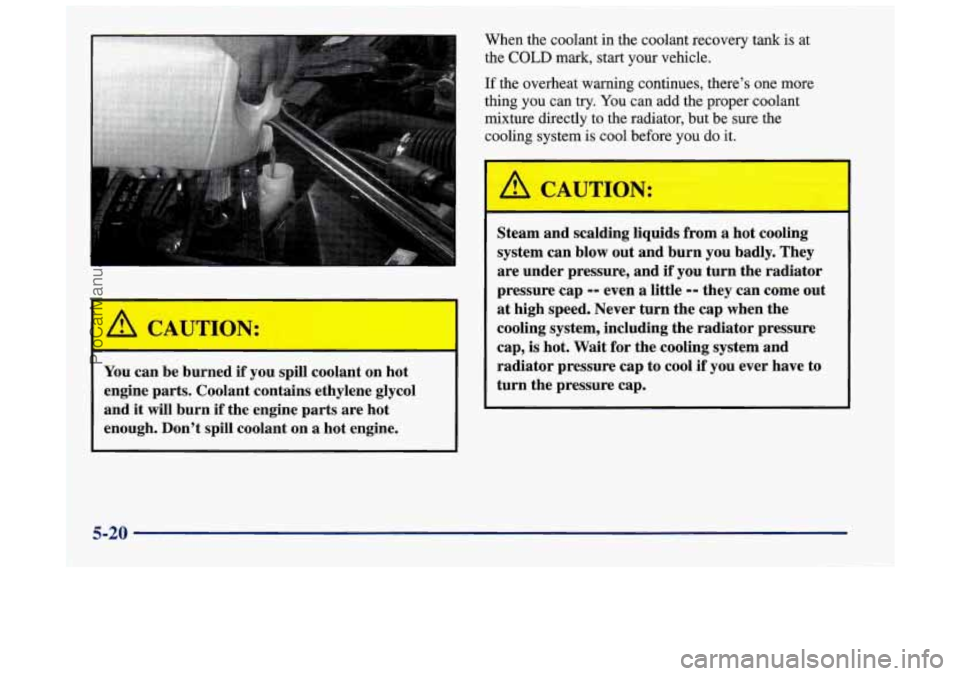
-4 the COLD mark, start your vehicle.
When the coolant
in the coolant recovery tank is at
A CAUTION:
You
can be burned if you spill coolant on hot
engine parts. Coolant contains ethylene glycol
and
it will burn if the engine parts are hot
enough. Don’t spill coolant on
a hot engine.
If the overheat waning continues, there’s one more
thing YOU can try. You can add the proper coolant
mixture directly to the radiator, but be sure the
cooling system is cool before you do it.
I A CAUTION:
Steam and scalding liquids from a hot cooling
system can blow out and burn you badly. They
are under pressure, and
if you turn the radiator
pressure cap
-- even a little -- they can come out
at high speed. Never turn the cap when the
cooling system, including the radiator pressure
cap,
is hot. Wait for the cooling system and
radiator pressure cap to cool
if you ever have to
turn the pressure cap.
5-20
ProCarManuals.com
Page 213 of 340
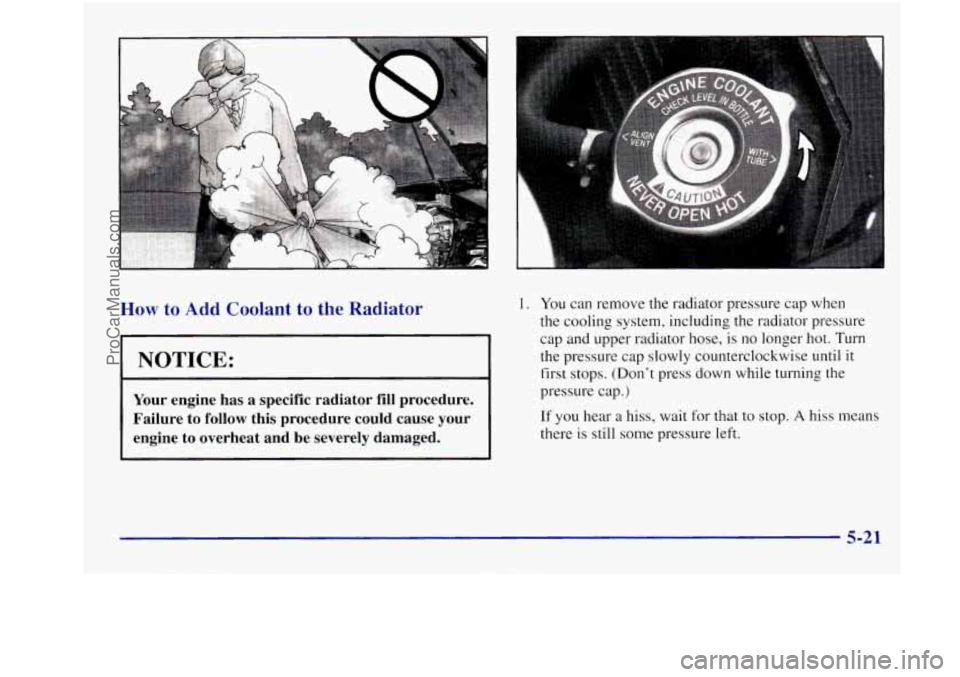
How to Add Coolant to the Radiator
NOTICE:
Your engine has a specific radiator fill procedure.
Failure to follow this procedure could cause
your
engine to overheat and be severely damaged.
1. You can remove the radiator pressure cap when
the cooling system, including the radiator pressure
cap and upper radiator hose, is no longer hot. Turn
the pressure cap
slowly counterclockwise until it
first stops. (Don't press down while turning the
pressure cap.)
If
you hear a hiss, wait for that to stop. A hiss means
there is still some pressure left.
5-21
ProCarManuals.com
Page 215 of 340
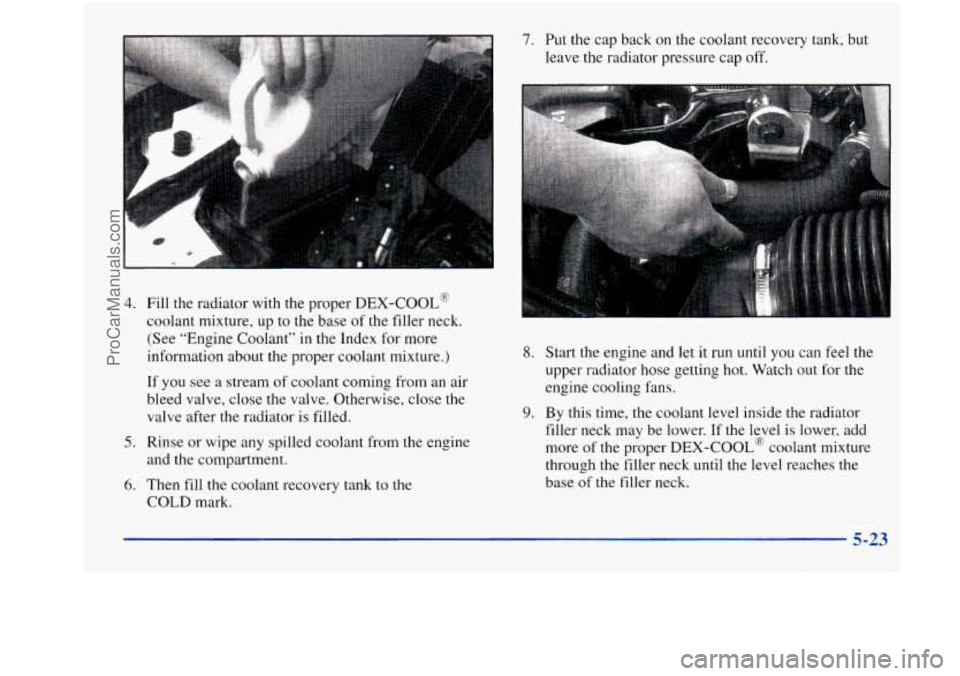
4. Fill the radiator with the proper DEX-COOL@
coolant mixture, up to the base
of the filler neck.
(See “Engine Coolant”
in the Index for more
information about the proper coolant mixture.)
If you see a stream of coolant coming from an air
bleed valve, close the valve. Otherwise, close the
valve after the radiator is filled.
5. Rinse or wipe any spilled coolant from the engine
and the compartment.
6. Then fill the coolant recovery tank to the
COLD mark.
7. Put the cap back on the coolant recovery tank, but
leave the radiator pressure cap off.
8. Start the engine and let it run until you can feel the
upper radiator hose getting hot. Watch out for the
engine cooling fans.
9. By this time, the coolant level inside the radiator
filler neck may be lower. If
the level is lower, add
more of the proper
DEX-COOL@ coolant mixture
through the filler neck until the level reaches the
base of the filler neck.
5-23
ProCarManuals.com
Page 238 of 340
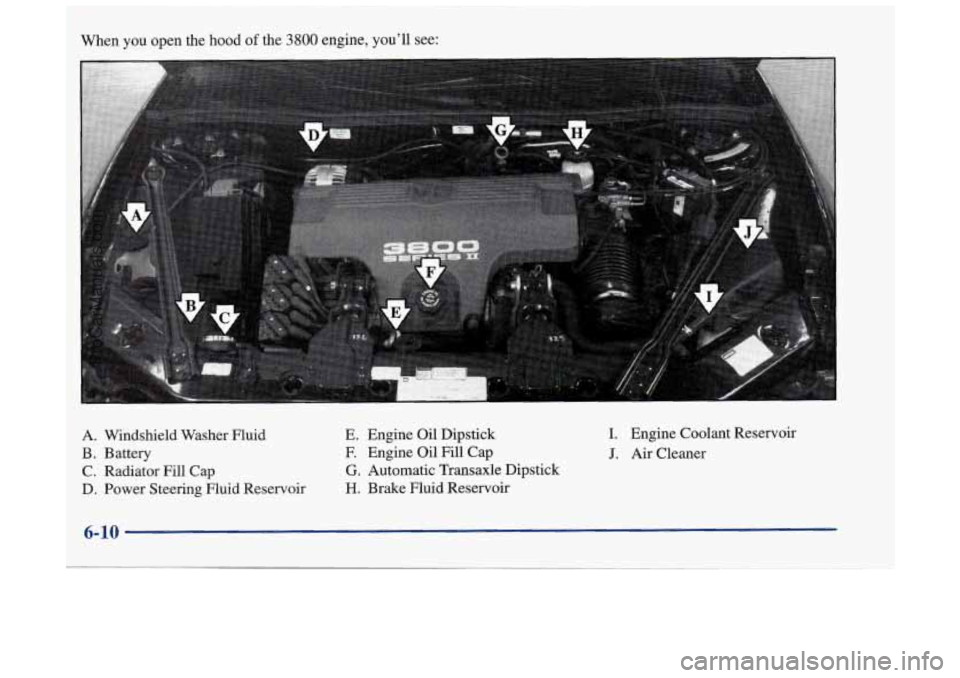
I. Engine Coolant Reservoir
J. Air Cleaner
Windshield
Washer Fluid
Battery
Radiator Fill Cap
Power Steering Fluid Reservoir E.
Engine Oil Dipstick F. Engine Oil Fill Cap
G. Automatic Transaxle Dipstick
H. Brake Fluid Reservoir
A.
B.
C.
D.
6-10
ProCarManuals.com
Page 251 of 340
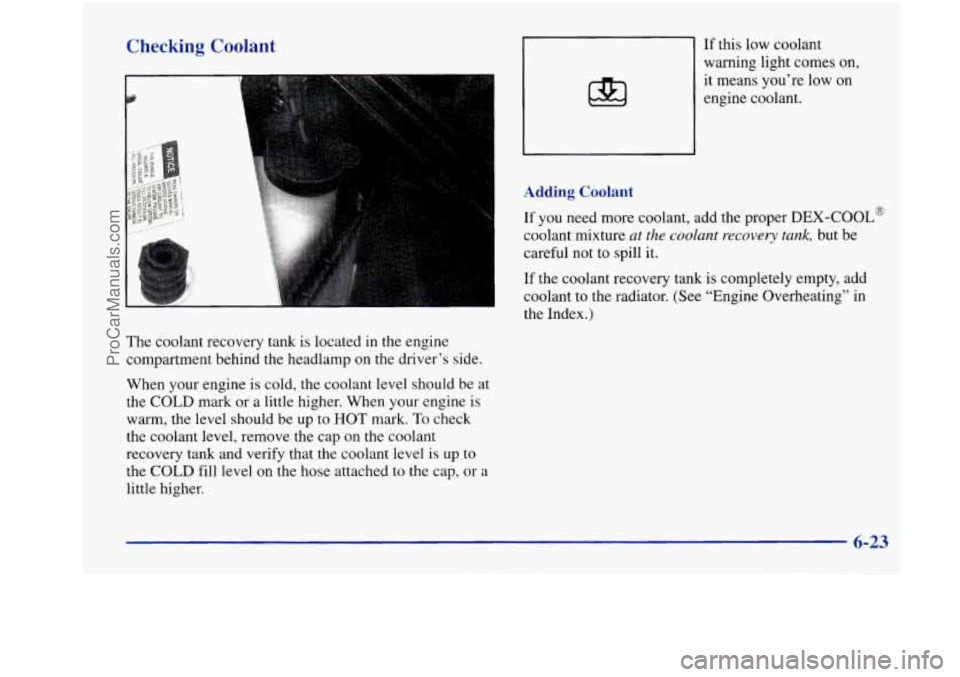
Checking Coolant
The coolant recovery tank is located in the engine
compartment behind the headlamp on
the driver’s side.
When your engine is cold, the coolant level should be at
the COLD mark or a little higher. When your engine is
warm, the level should be up to
HOT mark. To check
the coolant level, remove the cap on the coolant
recovery tank and verify that the coolant level is up to
the COLD fill level on the hose attached to
the cap, or a
little higher.
&I If this low coolant
warning light comes on,
it means you’re low on
engine coolant.
Adding Coolant
If you need more coolant, add the proper DEX-COOL@
coolant mixture
at the coolant recovery tank, but be
careful not to spill it.
If the coolant recovery tank is completely empty, add
coolant to
the radiator. (See “Engine Overheating” in
the Index.)
6-23
ProCarManuals.com
Page 252 of 340

'
A CAUTION: I
'hrning the radiator pressure cap when the
engine and radiator are hot can allow steam and
scalding liquids to blow out and burn you badly.
With the coolant recovery tank, you will almost
never have to add coolant at the radiator.
Never turn the radiator pressure cap
-- even a
little -- when the engine and radiator are hot.
You can be burned if
you spill coolant on hot
engine parts. Coolant contains ethylene glycol,
and it will burn if the engine parts are hot
enough. Don't spill coolant on
a hot engine.
Radiator Pressure Cap
NOTICE:
Your radiator cap is a 15 psi (105 kPa)
pressure-type cap and must be tightly installed
to
prevent coolant loss and possible engine damage
from overheating. Be sure the arrows
on the cap
line up with the overflow tube
on the radiator
filler neck.
When you replace your radiator pressure cap, an
AC@
cap is recommended.
Thermostat
Engine coolant temperature is controlled by a thermostat
in the engine coolant system.
The thermostat stops the
flow of coolant through the radiator until the coolant
reaches a preset temperature.
When you replace your thermostat, an
AC@ thermostat
is recommended.
6-24
ProCarManuals.com
Page 292 of 340
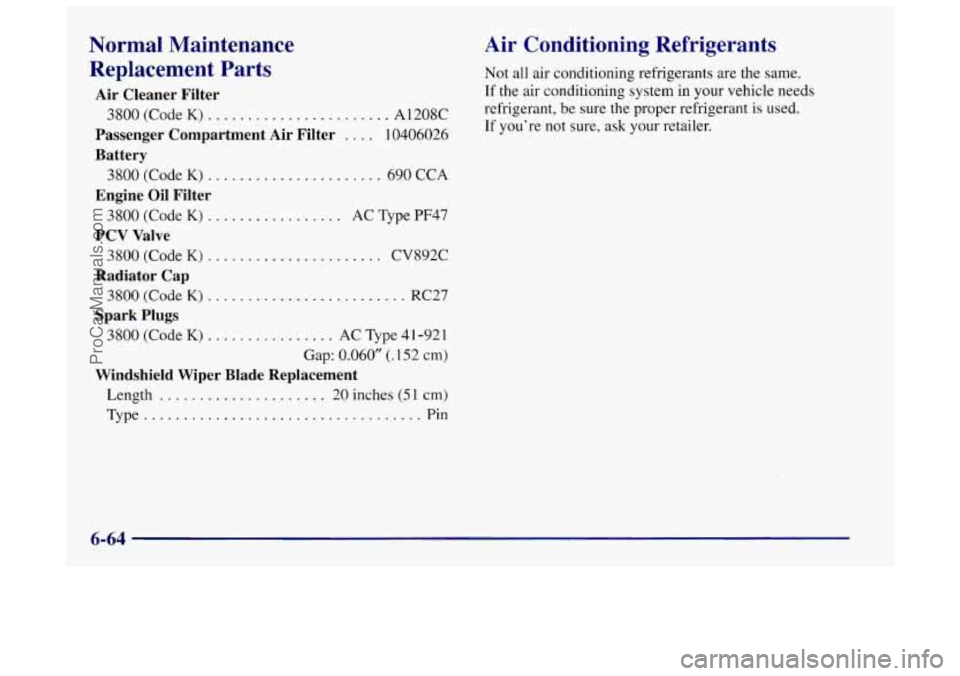
Normal Maintenance
Replacement Parts
Air Cleaner Filter
3800 (Code K) ....................... A1208C
Passenger Compartment Air Filter .... 10406026
3800 (Code K) ...................... 690 CCA
3800 (Code K) ................. AC Type PF47
3800 (Code K) ...................... CV892C
3800 (Code K) ......................... RC27
3800 (Code K) ................ AC Type 4 1-921
Battery
Engine Oil Filter
PCV Valve
Radiator Cap
Spark Plugs
Gap: 0.060” (. 152 cm)
Windshield Wiper Blade Replacement
Length ..................... 20 inches (5 1 cm)
Type
................................... Pin
Air Conditioning Refrigerants
Not all air conditioning refrigerants are the same.
If the air conditioning system in your vehicle needs
refrigerant,
be sure the proper refrigerant is used.
If you’re not
sure, ask your retailer.
6-64
ProCarManuals.com
Page 304 of 340

I Maintenance Schedule I
100,000 Miles (166 000 km)
Inspect spark plug wires.
0 Replace spark plugs.
0 Change automatic transaxle fluid and filter if the vehicle is mainly driven
An Emission Control Service.
An Emission Control Service.
under one or more of these conditions:
- In heavy city traffic where the outside temperature regularly reaches
90°F (32°C) or higher.
- In hilly or mountainous terrain.
- When doing frequent trailer towing.
- Uses such as found in taxi, police or delivery service.
If you do not use your vehicle under any of these conditions, the fluid and
filter do not require changing.
150,000 Miles (240 000 km)
0 Drain, flush and refill cooling system (or every 60 months since last service,
whichever occurs
first). See “Engine Coolant” in the Index for what to use.
Inspect hoses. Clean radiator, condenser, pressure cap and neck. Pressure test
the cooling system and pressure cap.
An Emission Control Service.
DATE
MILEAGE
ACTUAL I SERVICEDBY I
I DATE I
1 MILEAGE ACTUAL I SERVICEDBY: I
7-12
ProCarManuals.com